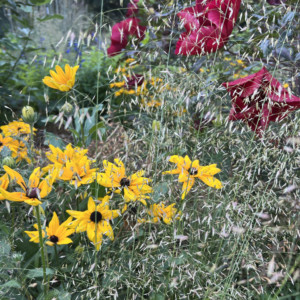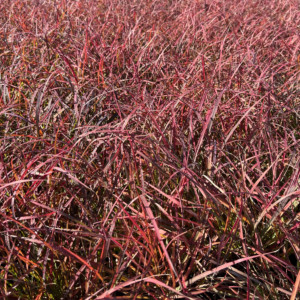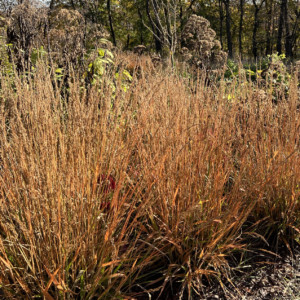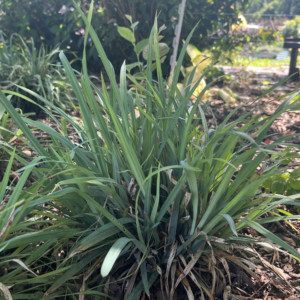Ornamental Grasses – You’ve come a long way baby!
25+ years ago as I sat in my first herbaceous plants class, I was less than impressed with ornamental grasses. I’m sure we studied other plants, but my brain only retained the sharp, finger-slicing edges of Miscanthus (not a great first impression).
It wasn’t until many years later that ornamental grasses made an impression and I started to appreciate this unique group of plants.

My latest fav – Calamagrostis ‘Cheju-Do’. On a cold November day, I dragged my husband to the studio garden of Donald Pell Gardens in Phoenixville, PA. While the gardens were preparing for their winter’s nap, the ornamental grasses and their structure caught my eye. Especially the orange-yellow glow of ‘Cheju Do’. A much shorter Calamagrostis than I was used to, this 24” grass seemed to be the perfect garden addition. The late fall color really was THAT GOOD!
The first six ‘Cheju-Do’ made their way into my garden the next spring (it didn’t take long), and I discovered what fantastic plants these were through the growing season! Tiny white hairs lining the green leaf blades are spectacular when covered with dew. I was hooked and never looked back – a.k.a. 50 more plants were ordered and planted within weeks.
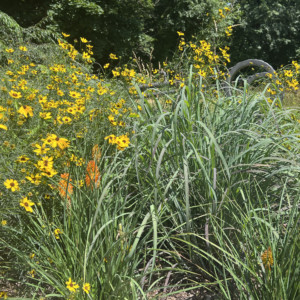
Height. It’s expected from a lot of ornamental grasses, right? I love the new(er) Andropogon cultivars from Intrinsic Perennials (https://www.intrinsicperennialgardens.com/). Whether ‘Blackhawks’, ‘Holy Smoke’, or ‘Red October’ – Big Bluestem is a delight. The purple-red foliage first hooked me, but I couldn’t ask for more resilient plants. I have Andropogon ‘Blackhawks’ in a former lawn area, not horrible soil but not bad either; it has performed well. But with ‘Holy Smoke’, I tried a rocky hill that would barely grow weeds. ‘Holy Smoke’ has been a rock star!
The 4-6’ tall plants are soft to the touch and provide so much movement in the garden. I paired Andropogon ‘Holy Smoke’ with Coreopsis x ‘Gilded Lace’ and Kniphofia ‘Orange Blaze’ – plus a few “pops” of Okra. Don’t knock it ‘til you try it!

Eragrostis. There is so much to love about Purple Love Grass (Eragrostis spectabilis). This petite bundle of love is great in the garden (think poor, dry soil) and in containers. The haze of purple flowers in the summer is sure to give you heart palpitations.
But have you seen Eragrostis trichodes? Sand Love Grass is slightly taller (2-4’) with a haze of white flowers. Picture it with Agastache ‘Blue Fortune’ just as the light is changing in the evening – breathtaking.

Throughout my career in horticulture, I have observed Little Bluestem (Schizachyrium scoparium) go from a simple native “weed” to an explosion into the landscape mainstream. The number of amazing selections on the market makes this an easily accessible plant for the masses. But are we always using it correctly?
Little Bluestem, as with many of our native grasses, thrives with good drainage and lower fertility. One would think this would be easy to incorporate into the landscape, that is until we install an irrigation system, heavily amend the soil, and/or do not train our staff to the needs of this plant. The three above-mentioned factors are all within our control.
While any plant that comes from a production nursery will need supplemental irrigation initially, it is just that – initially. As this plant takes hold and roots into the soil, overwatering can lead to an untimely death. Traditional irrigation systems are frequently installed by folks with turf knowledge and moisture requirements for turf vs. moisture requirements for Schizachyrium are vastly different. The same is true for soil amendments and supplemental fertilization, both over-fertilizing and over-watering will cause Little Bluestem to flop. Personally, I’m not a fan of floppy plants – are you?

So, let’s end with our native Carex sp. (the sedges) – the relatively new kids on the block in the commercial horticulture world. Carex pensylvanica graced our catalogs as the wonder plant for dry shade and is now produced by the tens of thousands. Carex stricta received acclaim as the perfect fit for rain gardens. And then in January 2023, our world was “rocked” by the Mt. Cuba report (https://mtcubacenter.org/trials/carex-for-the-mid-atlantic-region/), and we all wanted Carex woodii.
The genus Carex is a terrific group of plants that should be used in the landscape much more. Whether you are looking for a lawn alternative, a traditional groundcover, a matrix planting, or a stormwater management planting – a Carex will fit the bill. And the research from Mt. Cuba Center (Hockessin, DE) makes finding the right sedge for your site very easy. There is a sedge for every situation, but not every sedge will work in every situation!
The takeaway? Grasses have come a long way in the last 25 years. Whether due to improved varieties or simply a newfound acceptance (ex. meadows and naturalistic plantings where grasses play an integral role), this group of plants are sure to complement any landscape. As with any plant, it is critical to “learn” the grasses and understand their needs. When the needs are met, the result is a successful landscape.
